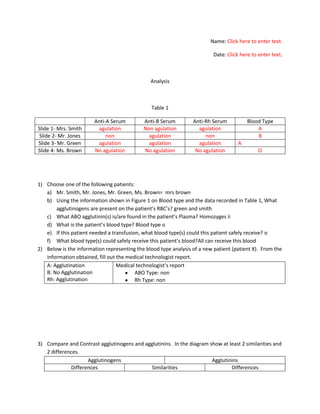
Analysis of Blood Typing Techniques
- 1. Name: Click here to enter text. Date: Click here to enter text. Analysis Table 1 Anti-A Serum Anti-B Serum Anti-Rh Serum Blood Type Slide 1- Mrs. Smith agulation Non agulation agulation A Slide 2- Mr. Jones non agulation non B Slide 3- Mr. Green agulation agulation agulation A Slide 4- Ms. Brown No agulation No agulation No agulation O 1) Choose one of the following patients: a) Mr. Smith, Mr. Jones, Mr. Green, Ms. Brown= mrs brown b) Using the information shown in Figure 1 on Blood type and the data recorded in Table 1, What agglutinogens are present on the patient’s RBC’s? green and smith c) What ABO agglutinin(s) is/are found in the patient’s Plasma? Homozyges ii d) What is the patient’s blood type? Blood type o e) If this patient needed a transfusion, what blood type(s) could this patient safely receive? o f) What blood type(s) could safely receive this patient’s blood?All can receive this blood 2) Below is the information representing the blood type analysis of a new patient (patient X). From the information obtained, fill out the medical technologist report. A: Agglutination Medical technologist’s report B: No Agglutination ABO Type: non Rh: Agglutination Rh Type: non 3) Compare and Contrast agglutinogens and agglutinins. In the diagram show at least 2 similarities and 2 differences. Agglutinogens Agglutinins Differences Similarities Differences
- 2. Click here to enter text. Click here to enter text. Click here to enter text. 4) Pretend you went with your class on a medical career field trip to a local hospital. One of the stops on the visit was to the hospital’s blood lab. The medical technologist at this stop gave a demonstration of how blood types are determined. Your job is to write a paragraph for the school newspaper on the visit to the blood lab, summarizing what you’ve learned about how ABO/Rh blood groups are determined. Write a paragraph and include the title. Click here to enter text. 5) List at least 3 situations where blood typing could be used. a) Blood donation b) transfution c) Emergency 6) Define Erythroblastosis Fetalis. Anemia in new born babies a) Describe the sequence of events that lead to this condition. Mothers antibodies attacking red blood cells b) What might be some benefits if the medical profession developed a shot or vaccination that could desensitize an Rh+ situation?Decrease in agulnation RH, anemic in new born babes 7) You are a type A eryhthorocyte placing an ad in the personals and you are seeking a compatible mate for a long lasting transfusion. Create an ad to be submitted to the newspaper. Hi there! My name is meg, im in serious need of a blood transfution of A blood or O blood type. I wioll give you ten bucks for how ever much your willing to offer!!contact me at hoopla-bloodtypeA 8) Another important diagnostic tool used by medical technologist is determining a patient’s blood cell count, for both red blood cells and white blood cells. When this procedure is performed, one technique used is to take multiple samples and calculate the average. This method of multiple sampling is a standard procedure in scientific and medical investigations. Discuss why this method is important in blood typing. This procedure is brilliant for blood typing because multiple sampling gives you a broad idea of the different types of blood and what can occur, like when we tested the four different types of teachers. 9) Each year thousands of people contract blood borne diseases. What could be done in a clinical blood lab to minimize the risk of obtaining or spreading a blood borne disease?Not allowing the different types to blood to mix and coming up with a vaccine that will help prevent the attacking of the red blood cells 10) In a short paragraph, identify what you think may be the next important breakthrough, milestone or discovery in the study of blood and blood diseases and explain why. I think if they come up with a vaccination that will help prevent blood didease or come up with a fake blood that will be able to go with all the blood types and help prevent diseases